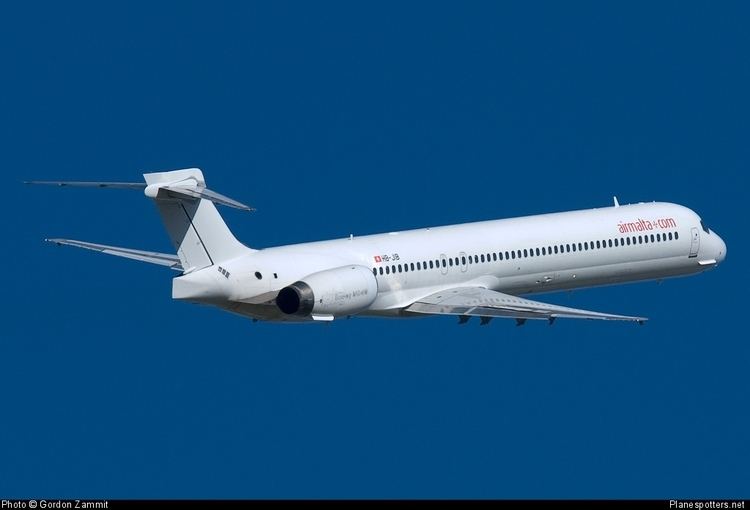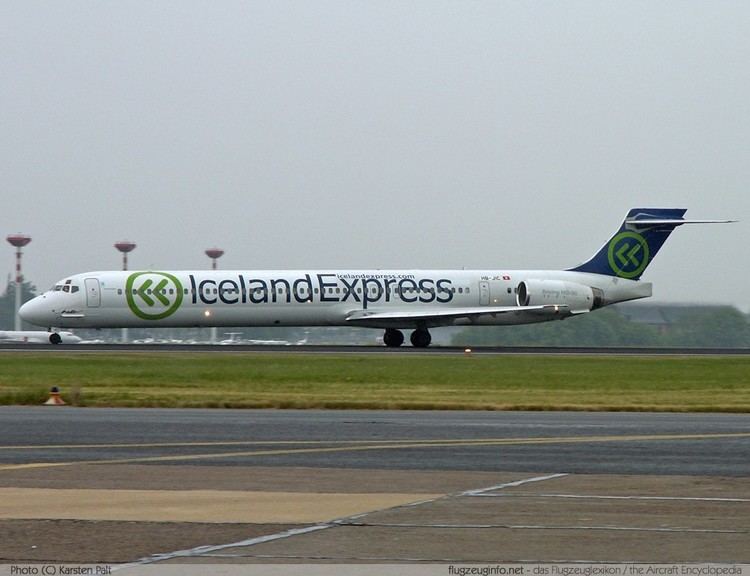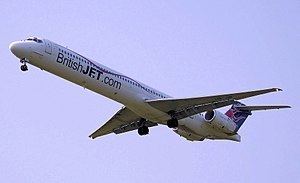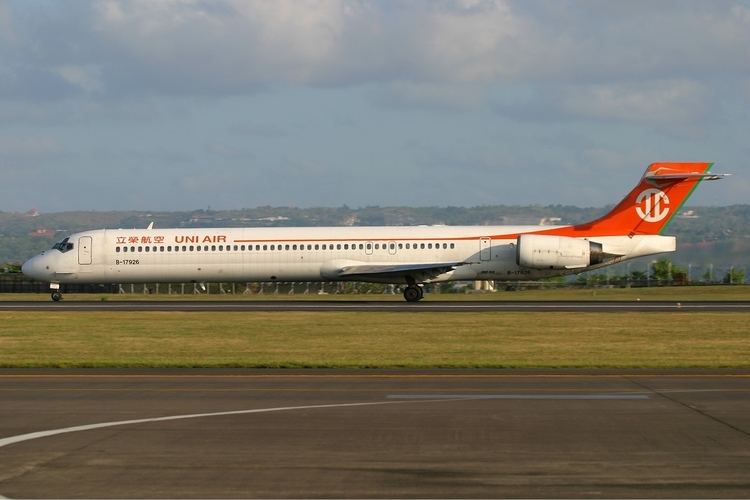Length 46 m Weight 39,920 kg Wingspan 33 m Unit cost 41,500,000–48,500,000 USD | Range 3,860 km Cruise speed 811 km/h | |
Delta airlines mcdonnell douglas md 90 30 takeoff 17 n928dn minneapolis
The McDonnell Douglas MD-90 is a twin-engine, short- to medium-range, single-aisle commercial jet airliner. The MD-90 was developed from the MD-80 series. Differences from the MD-80 include more fuel-efficient International Aero Engines V2500 engines and a longer fuselage. The MD-90 has a seating capacity of up to 172 passengers and was introduced into service with Delta Air Lines in 1995.
Contents
- Delta airlines mcdonnell douglas md 90 30 takeoff 17 n928dn minneapolis
- Mcdonnell douglas md 90 promo film 1994
- Background
- MD 90
- Variants
- Operators
- Accidents and incidents
- Specifications
- References

The MD-90 and the subsequent MD-95/Boeing 717 were derivatives of the MD-80, which itself was a derivative commercially introduced in 1980 from the DC-9.

Mcdonnell douglas md 90 promo film 1994
Background

The Douglas Aircraft Company developed the DC-9 in the 1960s as a short-range companion to their larger DC-8. The DC-9 was an all-new design, using two rear fuselage-mounted turbofan engines, and a T-tail. The DC-9 has a narrow-body fuselage design with a 5-abreast seating with a capacity of 80 to 135 passengers depending on seating arrangement and aircraft version.

The second generation of the DC-9 was originally called the DC-9-80 series or the DC-9 Super 80 but later marketed as the MD-80 and entered service in 1980. McDonnell Douglas began studies into shorter derivatives of the MD-80 in 1983, these studies eventually becoming known as the MD-90. While for several years, McDonnell Douglas proposed powering the MD-90 with two propfan engines, by 1989, it was clear that there was insufficient interest in prop fan powered aircraft, and reworked their proposals to feature the IAE V2500 turbofan instead.
MD-90
The MD-90 was firmly launched on November 14, 1989, when Delta Air Lines placed an order for 50 MD-90s, with options for a further 110 aircraft. The aircraft first flew on February 22, 1993 and the first MD-90 was delivered to Delta in February 1995. The MD-90 was produced adjacent to the Long Beach Airport in Long Beach, California, USA.

The MD-90 is a mid-size, medium-range airliner that was developed from the MD-80 series. It is a 5 feet (1.5 m) longer, updated version of the MD-88 with similar electronic flight instrument system (EFIS) and more powerful, quieter and fuel efficient IAE V2500 engines instead of the JT8D engines, which power the MD-80 series. This made the MD-90 the first derivative variant of the DC-9 to use a high-bypass turbofan engine. Typical seating for the MD-90 ranges from 153 to 172 passengers, depending on the cabin configuration and interior layout.
The MD-90 was produced in two versions: -30 and -30ER. The -30 has a range of 2,400 miles (3,860 km). The -30ER has a higher gross weight and range up to 2,750 miles (4,426 km) with an auxiliary fuel tank. An even longer range version, the -50, was offered but was never ordered.
The initial MD-90s feature an EFIS cockpit similar to the MD-88's cockpit. The 29 MD-90s delivered to Saudi Arabian Airlines feature a full glass cockpit with avionics and an overhead display panel similar to the MD-11's cockpit for easy transition for the airline's pilots of the MD-11, also operated by the airline.
No MD-90 orders were received after Boeing and McDonnell Douglas merged in 1997 due to internal competition with Boeing's 737. Delta Air Lines had initially placed a large order for the MD-90 to replace some aging Boeing 727s. After the Boeing-McDonnell Douglas merger, Delta canceled their remaining 19 MD-90 orders in favor of the Boeing 737-800. A total of 40 MD-90s (later 20) were to be assembled under contract in Shanghai, People's Republic of China under the Trunkliner program, but Boeing's decision to phase out the MD-90 resulted in only two built by Shanghai Aircraft.
MD-90 production at Long Beach, California ended in 2000 with the last airplane being delivered to Saudi Arabian Airlines, and MD-90T production at Shanghai ended in 2000. With 116 MD-90 aircraft produced, the MD-90 production run was the smallest among the DC-9 family. Two aircraft were also produced at Jiangwan Airfield in Shanghai, People's Republic of China.
Following the MD-90 in the DC-9 family was the MD-95, which was renamed the Boeing 717-200 after McDonnell Douglas (successor to Douglas Aircraft Company) merged with Boeing in 1997. The main competitors of the MD-90 included the Airbus A320 and the Boeing 737-800.
Variants
Operators
As of June 2016, Delta Air Lines is the sole remaining operator with 65 in active service.
Accidents and incidents
As of October 2015, the MD-90 has been involved in three incidents, including 2 hull-loss accident, with 1 fatality.
Specifications
Note: * With extra 565 gallon auxiliary fuel tank.
Sources: Boeing, Airlines.net
